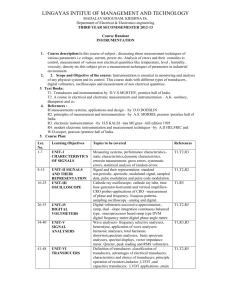3.0 Analog Sensors and Transducers
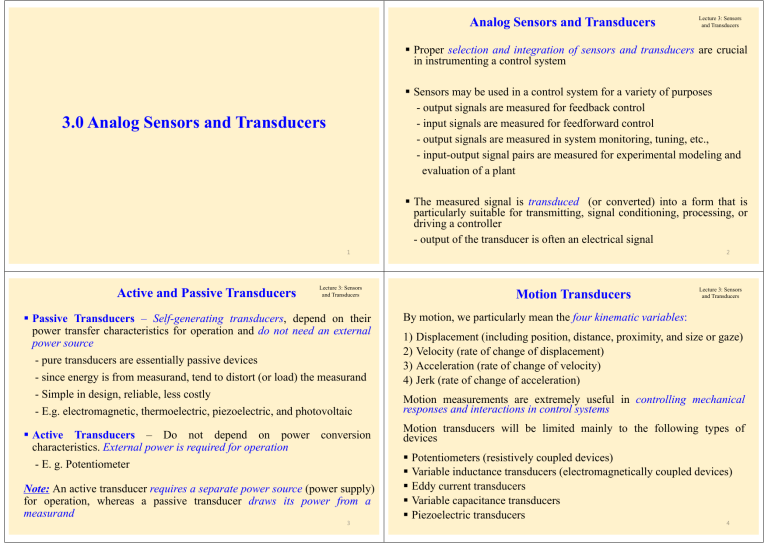
3.0 Analog Sensors and Transducers
1
Analog Sensors and Transducers
Lecture 3: Sensors and Transducers
Proper selection and integration of sensors and transducers are crucial in instrumenting a control system
Sensors may be used in a control system for a variety of purposes
- output signals are measured for feedback control
- input signals are measured for feedforward control
- output signals are measured in system monitoring, tuning, etc.,
- input-output signal pairs are measured for experimental modeling and evaluation of a plant
The measured signal is transduced (or converted) into a form that is particularly suitable for transmitting, signal conditioning, processing, or driving a controller
- output of the transducer is often an electrical signal
2
Active and Passive Transducers
Lecture 3: Sensors and Transducers
Passive Transducers
–
Self-generating transducers
, depend on their power transfer characteristics for operation and do not need an external power source
- pure transducers are essentially passive devices
- since energy is from measurand, tend to distort (or load) the measurand
- Simple in design, reliable, less costly
- E.g. electromagnetic, thermoelectric, piezoelectric, and photovoltaic
Active Transducers
– Do not depend on power conversion characteristics.
External power is required for operation
- E. g. Potentiometer
Note: An active transducer requires a separate power source (power supply) for operation, whereas a passive transducer draws its power from a measurand
3
Motion Transducers
Lecture 3: Sensors and Transducers
By motion, we particularly mean the four kinematic variables
:
1) Displacement (including position, distance, proximity, and size or gaze)
2) Velocity (rate of change of displacement)
3) Acceleration (rate of change of velocity)
4) Jerk (rate of change of acceleration)
Motion measurements are extremely useful in controlling mechanical responses and interactions in control systems
Motion transducers will be limited mainly to the following types of devices
Potentiometers (resistively coupled devices)
Variable inductance transducers (electromagnetically coupled devices)
Eddy current transducers
Variable capacitance transducers
Piezoelectric transducers
4
Examples
Lecture 3: Sensors and Transducers
The rotating speed of a work piece and the feed rate of a tool are measure d in controlling machining operations
Displacements and speeds (both angular and translatory) at joints (revolut e and prismatic) of robotic manipulators in controlling manipulator traject ory
In high-speed ground transit vehicles, acceleration and jerk measurements can be used for active suspension control
Angular speed in the control of rotating machinery, such as turbines, pum ps, compressors, motors, and generators in power-generating plants
Proximity sensors and accelerometers are used in machine protection syst ems for condition monitoring, fault detection, diagnostic, and on-line (oft en real-time) control of large and complex machinery
5
Potentiometers
Lecture 3: Sensors and Transducers
Potentiometer, or pot
, is a displacement (active) transducer
Consists of a uniform coil of wire or a film of high-resistive material – such as carbon, platinum, or conductive plastic, whose resistance is proportional to its length
Constant voltage is applied across the coil using external dc supply
Schematic of a potentiometer Potentiometer loading
7
Measure of one kinematic variable to obtain any one of the remaining depends on
Lecture 3: Sensors and Transducers
The nature of the measured signal ( steady, highly transient, periodic, bandwidth
)
The required frequency content of the processed signal (or the frequency range of interest)
The signal-to-noise ratio (SNR) of the measurement
Available processing capabilities (e.g., analog or digital processing, limitations of the digital processor, and interface, such as the speed of processing, sampling rate, and buffer size)
Controller requirements and the nature of the plant ( e.g., time constants, delays, complexity, hardware limitations
)
Required accuracy as the end objective
6
Potentiometers (Contd..)
Lecture 3: Sensors and Transducers
The transducer output signal is the dc voltage between movable contact (wiper arm) and one terminal of the coil
Slider displacement x is proportional to the output voltage
This relationship assumes that output terminals are in open-circuit
- a load of infinite impedance is present at the output terminals,
- so that the output current is zero
In practice, the load (circuitry into which pot signal is fed - e.g., conditioning, interfacing, etc.,) has a finite impedance
- the output current (current through the load) is non-zero
The output voltage thus drops to under load variations, is known as electrical loading effect of the transducer
8
Rotatory Potentiometers
Lecture 3: Sensors and Transducers
Potentiometers that measure angular (rotatory) displacements are more common and convenient
In conventional designs of rectilinear (translatory) potentiometers, the length of the resistive element has to be increased in proportion to the measurement range or stroke
9
Angular motions (rotatory)
Example (1): (Loading nonlinearity)
Lecture 3: Sensors and Transducers
Consider the rotatory potentiometer shown below. Discuss the significance of the loading nonlinearity error caused by a purely resistive load connected to the pot.
Solution
For a general position of the pot slider arm, suppose that the resistance in the output (pick-off) segment of the coil is Note that, assuming a uniform coil,
Potentiometers
Lecture 3: Sensors and Transducers
Limitations and disadvantages
Variations in the supply voltage cause error
Electrical loading error can be significant when the load resistance is low
Wear out and heating up in the coil and slider contact cause accelerated degradation
Resolution is limited by the number of turns in the coil and the coil uniformity
High frequency measurements are not feasible because of slider surface, friction and inertia etc.,
Advantages
Potentiometers are relatively less costly
Provide high-voltage output signals, requiring no amplification in most applications
10
Solution (Contd..)
Lecture 3: Sensors and Transducers where, is the load resistance. Multiply eq by and use eq. of
By simplifying, we get where is the total resistance coil.
Current balance at the sliding contact (node)
Loading error appears to be high for low values of the
Good accuracy is possible for ratio
, particularly for small of values
11 12
Solution (Contd..)
Therefore, to reduce the loading error in pots,
- Increase the
- Use pots to measure small values of
The loading nonlinearity error
/
/
Note that this error is always negative
If the load resistance is small, a voltage follower may be used
Load resistance ratio
/
0.1
1.0
10.0
Loading nonlinearity error (e) at
/
71.4%
20%
2.4%
Lecture 3: Sensors and Transducers
13
.
Example (2):
Lecture 3: Sensors and Transducers
A mobile robot uses a potentiometer attached to the drive wheel to record its travel during autonomous navigation. The required resolution for robot motion is 1mm, and the diameter of the drive wheel of the robot is 20cm.
Examine the design considerations for a standard (single-coil) rotatory pot entiometer to be used in this application.
Solution
Assume that the potentiometer is directly connected (without gears) to the drive wheel. The required resolution for the pot is
This resolution is feasible with a coil-type rotatory pot
The number of turns in the coil = 100/0.16 = 625 turns. Assuming an average pot diameter of 10cm and denoting the wire diameter by d
, we have, pot circumference = mm
15
Performance considerations
Lecture 3: Sensors and Transducers
The force required to move the slider arm comes from the motion source
- Energy dissipation due to friction
Electrical energy from the reference source is dissipated through the resistive element
- Undesirable temperature rise
Finite resolution in coil type pots
. For a coil with
N turns,
Resolution,
Resolutions better than 0.1% (1000 turns) are available with coil potentiometers
Very high resolutions (infinitesimal) are possible with conductive plastic resistive film potentiometers
14
Solution (Contd..) Lecture 3: Sensors and Transducers
Now, taking the resistance of the potentiometer to be 5 Ω and the resistivity of the wire to be 4 μΩ cm, the diameter
D of the core of the coil is given by,
. /
Note: Resistivity = (resistance) (cross-section area)/(length)
Sensitivity
The sensitivity of a potentiometer represents the change ( ) in the output signal associated with a given change ( ) in the measurand (the displacement)
∆
∆
Or, in the limit,
16
Optical Potentiometer
Lecture 3: Sensors and Transducers
The optical potentiometer is a displacement sensor
A layer of photoresistive material is sandwiched between a layer of regular resistive material and a layer of conductive material
The photoresistive layer is practically an electrical insulator when no light is projected on it
Current through the load is
Hence, the voltage drop across across , is given by
Note that is the fractional position of the light spot.
Lecture 3: Sensors and Transducers
, which is also the voltage
Current balance at the junction of three resistors is
When,
⇒
, we have . Hence, above eq. becomes
An optical potentiometer
Optical Potentiometer Characteristics
Equivalent circuit
/
17
Lecture 3: Sensors and Transducers
The behavior of the optical potentiometer becomes more linear for higher values of load resistance
19
The relationship is still nonlinear in decreases, however, with decreasing vs . Nonlinearity
18
Variable Inductance Transducers
Lecture 3: Sensors and Transducers
Motion transducers that employ the principle of electromagnetic induction are termed as variable-inductance transducers
Types of variable inductance transducers include
Mutual-induction transducers
Self-induction transducers
Permanent magnet transducers
Variable inductance transducers that use a non-magnetized ferromagnetic medium to alter the reluctance of the flux path are known as variable reluctance transducers
Some of the mutual-induction transducers and most of the self-induction transducers are of variable reluctance type
But, permanent magnet transducers are not variable reluctance type
20
Mutual-Induction Transducers
Lecture 3: Sensors and Transducers
Mutual induction transducers constitutes two coils
- Primary winding
- Secondary winding
Primary winding carries an AC excitation that induces a steady AC voltage in the secondary winding
The amplitude of the induced voltage depends on the flux linkage between the two coils
In mutual induction transducers, change in the flux is effected by
- Moving a ferromagnetic material on the flux path:
LVDT, RVDT, mutual induction proximity probe
- Moving one coil with respect to the other: resolver, synchrotransformer
21
LVDT Operation
Lecture 3: Sensors and Transducers
When the core moves the reluctance of the path changes and the degree of flux linkage depends on the core position
Since, the two secondary windings are connected in series opposition, when the core is at the center the output is zero (null position)
In the linear operating range o/p voltage is proportional to the core displacement
It provides magnitude as well as the direction. Direction can be obtained by
- Demodulating the signal or
- Phase angle of the o/p signal
To measure transient motions accurately the reference signal frequency has to be at least 10 times larger than the largest frequency component of the measurand
23
Linear Variable Differential Transformer (LVDT)
Lecture 3: Sensors and Transducers
A typical operating curve
Schematic diagram of LVDT
LVDT consists of an insulating, nonmagnetic cylinder that has a primary coil in the mid-segment and secondary coil symmetrically wound in the two end segments
The primary coil is energized by an AC supply voltage, which will gene rate, by mutual induction, an AC of the same frequency in the secondary winding
22
Example (3):
Lecture 3: Sensors and Transducers
An equivalent circuit for a differential transformer is shown below. The resistance in the primary winding is denoted by , and the corresponding inductance is denoted by . The total resistance of the secondary winding is . The net leakage inductance, due to magnetic flux leakage, in the segments is denoted by signal.
. The load resistance is and the load inductance is . Derive an expression for the phase shift in the output
24
Solution:
The magnetizing voltage in the primary coil is given by
Lecture 3: Sensors and Transducers
Solution: (Contd..)
It follows that the output voltage at the load is given by
Lecture 3: Sensors and Transducers in the frequency domain. Suppose that the segment of the secondary winding that has full flux linkage through the ferromagnetic core receives an induced voltage that is proportional to the primary magnetizing voltage
.
The other segment receives only a portion of this voltage
, depending on the displacement of the core
. The net induced voltage is proportional to and is given by
This corresponds to a phase lead at the output, given by
Note that the level of dependence of the phase shift on the load and secondary circuit can be reduced by increasing the load impedance.
where is a proportionality constant.
25
Signal Conditioning
Lecture 3: Sensors and Transducers
Rectification
Displacement
(Measurand)
Carrier
Frequency
Generator
Primary
Excitation
LVDT
DC
Power
Supply
Rectifier
Circuit
Secondary
Output
DC
Amplifier
Low-pass
Filter
Measurement
AC output from the LVDT is rectified to obtain a DC signal
This signal is amplified and then low-pass filtered to eliminate any highfrequency noise components
Phase shift of the LVDT output has to be checked separately to determine the direction of motion
27
26
Demodulation
Lecture 3: Sensors and Transducers
Carrier frequency component is rejected from the output signal by comparing it with a phase-shifted and amplitude adjusted version of the reference signal
Differential transformers with built in signal conditioning are commonly available today
DC differential transformers have built in oscillators to generate the carrier signal. The supply voltage is usually 25V and output voltage is
5V
Carrier DC
Frequency
Generator
Power
Supply
Phase
Shift
Amplitude
Matching
Displacement
(Measurand)
LVDT Demodulator
DC
Amplifier
Lowpass
Filter
Measurement
28
Nature of signals at various locations in LVDT measurement circuit
Lecture 3: Sensors and Transducers
29
Rotary Variable Differential Transformer (RVDT)
Lecture 3: Sensors and Transducers
Operates using the same principle as LVDT, except that in RVDT, a rotating ferromagnetic core is used
31
Advantages of LVDTs
Lecture 3: Sensors and Transducers
Essentially non-contacting with no frictional resistance. Near ideal electromechanical energy conversion and light weight core result in very small resistive forces. Hysteresis is negligible.
Low output impedance ~ 100 ohm (Signal amplification is usually not needed)
Directional measurements (positive/negative) are obtained
Available in small size 1cm long with 2mm displacement
Simple and robust construction (inexpensive and durable)
Fine resolution are possible (better than potentiometer)
30
Lecture 3: Sensors and Transducers
Advantages of RVDT are essentially same as those mentioned for LVDT
Since, the RVDT measures angular motions directly, without requiring nonlinear transformations, its use is convenient in angular position servos
The linear range is typically
1%
, with a nonlinearity error less than
Variable Inductance Devices
Induced voltage is generated through the rate of change of magnetic flux
Displacement measurements are distorted by velocity: velocity measurements are distorted by acceleration
For the same displacement, the transducer reading depends on the velocity at that displacement, called rate error
This error is proportional to
(cyclic velocity of the core)/(carrier frequency)
Error rates can be reduced by increasing carrier frequency
32
Mutual-Induction Proximity Sensor
Lecture 3: Sensors and Transducers
33
Resolver
Lecture 3: Sensors and Transducers
Resolver is a mutual-induction transducer, which is used to measure the angular displacements
Lecture 3: Sensors and Transducers
Proximity sensors are used in a wide variety of applications pertaining to non-contacting displacement sensing and dimensional gaging
Generally used to measure
- Transverse displacements
- Small displacement (nonlinear)
- Presence or absence
Mechanical loading is negligible (non-contacting)
Applications include
- Robotic measurement and control of the gap between a robotic welding torch head and the work surface
- Angular speed measurement at steady state, by counting the number of rotations per unit time
- Level detection (eg., in the filling)
- Bottling plant to check whether the lid is placed
34
Let the carrier primary signal, Lecture 3: Sensors and Transducers
If the angular position of the rotor w.r.t one of the stator is , then
Induced voltages,
The induced quadrate signals are
Multiply each quadrate signal by to get
The rotor contains the primary coil and is energized by the AC supply voltage
The rotor is directly attached to the object whose direction is being measured
The stator consists of two sets of windings placed apart
35
Low pass filter with a cutoff set at , gives demodulated outputs as
36
Lecture 3: Sensors and Transducers
Advantages
Fine resolution and high accuracy
Low output impedance
Small size (10mm diameter)
Simple and robust construction
Limitations
Nonlinear output signals
Bandwidth limited by supply frequency
Slip rings and brushes would be necessary if multiple rotations to be measured (a brushless resolver can eliminate this)
37
Synchro Transformer
The synchro is somewhat similar to the operation of the resolver
Lecture 3: Sensors and Transducers
Employs two identical rotor-stator pairs
Each stator has three sets of windings apart
Transmitter rotor is energized with supply voltage. This includes voltages in the three stator windings
39
Example (4):
Lecture 3: Sensors and Transducers
The two output signals and of the resolver are termed as quadrature signals.
Show how these quadrature signals could be demodulated to obtain the speed of rotation directly.
Solution
If the angular speed is denoted by the quadrature signals, at steady speed, may be expressed as
By differentiating these signals, we get
Hence,
(or)
Each relation provides direction as well as magnitude of the speed
38
Lecture 3: Sensors and Transducers
Since, the windings of the transmitter stator are connected to the receiver s tator windings, a voltage is induced in the receiver rotor
If the angle between the drive rotor and a stator winding is , the resultant magnetic field on the receiver stator will make the same angle with the cor responding stator winding
If the receiver rotor is aligned with this magnetic field, the induced voltage will be maximum
If the receiver rotor is at to this resultant magnetic field, then the induc ed voltage will be zero
Synchros are operated near where the output voltage is zero
40
Self-Induction Transducers
Lecture 3: Sensors and Transducers
Transducers are based on the principle of self-induction. Unlike mutualinduction transducers, only a single coil is employed
When the coil is energized
, the current produces a magnetic flux
The level of flux linkage (self-inductance) can be varied by moving a ferromagnetic object within the magnetic field
This movement changes the reluctance path and inductance
This change in inductance is measured using an inductance measuring circuit
41
Summary (Contd..)
Lecture 3: Sensors and Transducers
Mutual-Induction proximity sensor
- it is a displacement transducer, operates on mutual-induction principle
- unlike LVDT and RVDT, the two voltages induced in the secondary winding segments are additive in this case
Resolver: Mutual induction transducer, measures angular displacements
Synchro transformer:
Similar in operation to the resolver
, differences are
- employs two identical rotor-stator pairs
- each stator has 3 sets of windings, placed shaft apart around the rotor
Self-Induction transducers
- based on the principle of self-induction
- unlike mutual-induction, only a single coil is employed
43
Summary
Lecture 3: Sensors and Transducers
Active transducers require a separate power source (power supply) for the operation, whereas a passive transducer draws its power from a measure signal (measurand)
Motion measurements are extremely useful in controlling mechanical responses and interactions in control systems:
1) Displacement 2) Velocity 3) Acceleration 4) Jerk
Discussion of motion transducers will be limited to mainly the following:
1) Potentiometers 2) Variable-inductance transducers
3) Eddy current transducers 4) Variable-capacitance transducers
5) Piezoelectric transducers
Signal conditioning associated with differential transformers includes filtering and amplification
Rectification and
Demodulation are commonly used to interpret the crude output signal from differential transformer
42


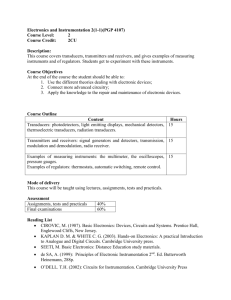
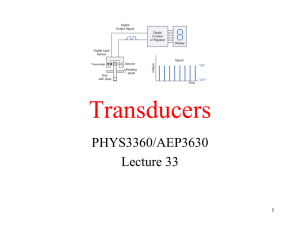
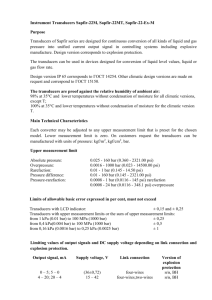
![Transducers_1[1]](http://s2.studylib.net/store/data/005329047_1-b90da3eabfa98717d13e735055577e1f-300x300.png)
